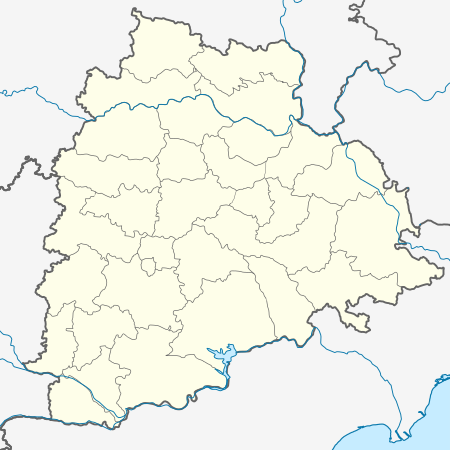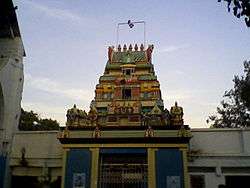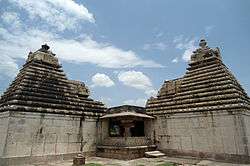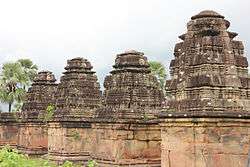Koti Lingala
Koti Lingala is a Hindu pilgrimage site in Jagtial district of the Indian state of Telangana. It is situated in Velagatoor mandal of the district, on the Godavari river.[1] It is located on the bank of the Godavari River, and has a traditional Shiva temple for Hindus, the Koteswara Siddeswara Temple.[1]
Koti lingala | |
|---|---|
Holy Site | |
 Koti lingala Location in Telangana, India  Koti lingala Koti lingala (India) | |
| Coordinates: 18.861255°N 79.196488°E | |
| Country | |
| State | Telangana |
| District | Jagtial |
| Languages | |
| • Official | Telugu |
| Time zone | UTC+5:30 (IST) |
| Vehicle registration | TS |
| Website | telangana |
Archaeological discoveries at Kotilingala indicate that it was an important town in ancient town, during the period of the Assaka mahajanapada and the Satavahanas.
History
Kotilingala has an archaeological site that was excavated by V. V. Krishna Sastry. The site has a mud fort with several gates and running 1054 metres long and 330 metres wide. A watch tower located in the south-eastern corner measures 11.5 * 10.55 m.[2] Ancient pottery, beads, bricks querns, and other artifacts have been found at the site.[3] Two hoards of punch-marked coins attributed to 2nd and 3rd centuries BCE have been found at the site.[4] These coins were issued by Gobhada and Samagopa, who are believed to be local pre-Satavahana rulers.[5]
Based on these discoveries, Kotilingala is believed to be a town of the ancient Assaka (also Andhra or Ashmaka) mahajanapada.[6][7] The mud fortification, protected by a stream on its east and the Godavari river on its west, indicate its high political and commercial significance.[3]
Satavahanas
Coins of Satavahana kings have also been found at Kotilingala. A few of these are copper and potin coins bearing the legend "Rano Siri Chimuka Satavahanasa". Some scholars such as A. M. Sastry and K. D. Bajpai have identified the issuer of these coins with Simuka, who is considered as the founder of the Satavahana dynasty based on the Puranic genealogies.[8] However, others such as P. L. Gupta and I. K. Sarma have disputed this identification, arguing that the Kotilingala coins belonged to a later ruler with a similar or same name.[8][9] P.V.P. Sastry, who first discovered these coins and attributed them to Simuka in 1978, also changed his view and later stated that Chimuka or Chhimuka of Kotilingala was not same as the Simuka mentioned in Naneghat inscription.[10]
Other coins include those issued by Kanha and Satakarni.[11] The inscriptions of the early Satavahanas have been found only in present-day Maharashtra (at Nashik and Naneghat), based on which western Deccan has been proposed as the original home of the Satavahanas. However, the discovery of coins at Kotilingala and other sites in present-day Andhra Pradesh and Telangana has prompted some historians such as M. Rama Rao to theorize that the eastern Deccan was also a part of the early Satavahana territory.[12] V. V. Krishna Sastry theorized that the site was once a stronghold of the early Satavahanas.[3] D. R. Reddy and S. Reddy proposed that Kotilingala was the original homeland of the Satavahanas. However, the Satavahana coin samples from Kotilingala are small in size, and it is not known where these coins were minted.[4] S. Chattopadhyaya argues that coins can travel via trade, and this is not conclusive evidence of the early Satavahana presence in eastern Deccan.[13] The archaeological evidence at Kotilingala suggests existence of long-distance trade.[4]
Developments
The State government has decided to construct a protection wall along the shores of river Godavari to protect the site from submergence under the backwaters of the Sripada Yellampalli project.[14][15] There were transportation facilities to the towns located on the bank of the river Godavari such as Godavarikhani, Jagtial, Mancherial, and Karimnagar.
References
- "Koti Lingala, a major pilgrim destination". The Hindu. 26 September 2014. Retrieved 2 July 2016.
- Material culture of Deccan: with special reference to Satavahana-Ikshvaku period, B.S. R. Babu, Agam Kala Prakashan, Hyderabad, 1999; p. 42
- V. V. Krishna Sastry (1983). The Proto and Early Historical Cultures of Andhra Pradesh. Government of Andhra Pradesh. p. 126.
- Carla M. Sinpoli (2001). Susan E. Alcock (ed.). Empires: Perspectives from Archaeology and History. Cambridge University Press. pp. 168–169. ISBN 978-0-521-77020-0.
- D. Raja Reddy; P. Suryanarayana Reddy (1987). Kotalingala coinage of Satavahanas and other local rulers: a profile. Numismatic Society of Hyderabad. p. 59.
- Peter Bernholz; Roland Vaubel (2014). Explaining Monetary and Financial Innovation: A Historical Analysis. Springer. p. 55. ISBN 978-3-319-06109-2.
- B. Subrahmanyam (1998). Buddhist Relic-Caskets In South India. Bharatiya Kala Prakashan. p. 9. ISBN 978-81-86050-15-6.
- Himanshu Prabha Ray (1986). Monastery and guild: commerce under the Sātavāhanas. Oxford University Press. p. 43.
- Inguva Karthikeya Sarma (1980). Coinage of the Satavahana Empire. Agam. pp. 126–30.
- Ajay Mitra Shastri (1999). The Age of the Sātavāhanas. Aryan Books. p. 306. ISBN 978-81-7305-158-6.
- Indian History, Krishna Reddy; Tata-McGraw Hill Education, New Delhi, 2011. p. A-250
- P. Raghunadha Rao (1993). Ancient and medieval history of Andhra Pradesh. Sterling Publishers. ISBN 978-81-207-1495-3.
- Sudhakar Chattopadhyaya (1974). Some Early Dynasties of South India. Motilal Banarsidass. pp. 18–19. ISBN 978-0-8426-0618-9.
- Special Correspondent (11 September 2014). "Protection wall for Koti Lingala temple". The Hindu. Retrieved 11 September 2014.
- "Koti Lingala on the verge of Submergence". The Hindu. Retrieved 14 July 2014.


